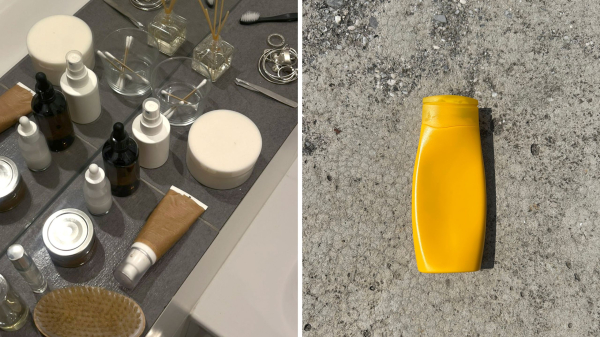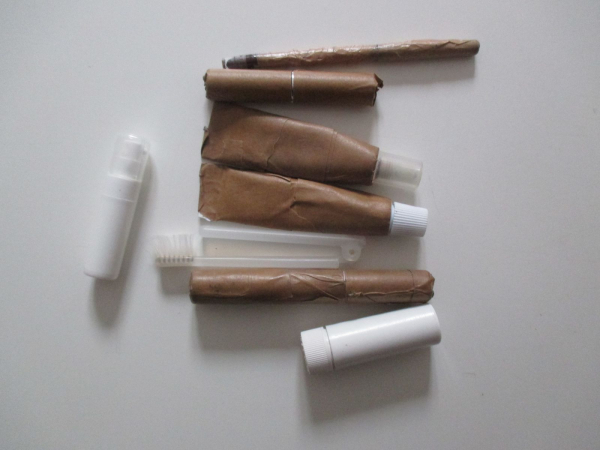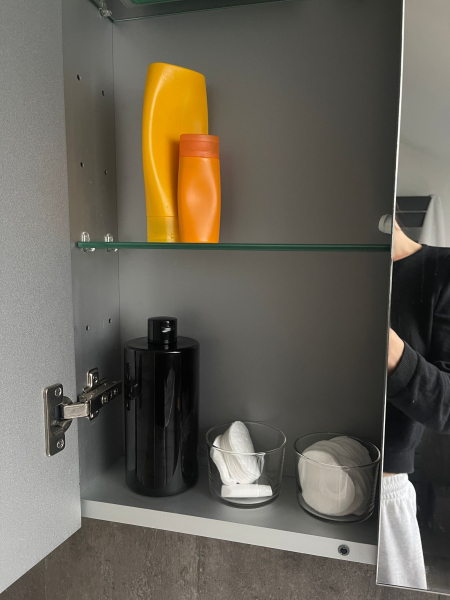 Courtesy of Lola Dement Myers, Angelika.Save this storySave this story
Courtesy of Lola Dement Myers, Angelika.Save this storySave this story
In a world flooded with logos, labels, and constant branded noise, even our most mundane daily rituals—washing our faces, taking showers, brushing our teeth—are interrupted by visual marketing cues. A glance around my bathroom reveals a melange of colors, shapes, and fonts, all competing for my attention and reminding me that my hair is dry, my skin is dull, and my scars need fading. This constant barrage overshadows the self-care experience, hijacking my focus and frankly, tiring me out.
It sometimes feels like there is no escape from the overstimulating, invasive branding that cohabits our most personal spaces—and it’s not just me. While not widely studied, the concept of “brand fatigue” is creeping into our common vernacular as people push back against the way every waking moment is used as an opportunity to sell us something. Digital marketers are beginning to notice and explore ways to counter this feeling—but what if consumers could solve the problem themselves? What if we just stripped all the brand fodder away?
A growing number of people are doing just that by engaging in a practice the internet has dubbed “visual decluttering,” a.k.a. removing product labels to reveal the plain packaging underneath or decanting products into unlabeled containers and repeating the process with product refill pouches. At first glance, it appears to be a purely aesthetic choice—but it's actually a quiet rebellion hiding under the guise of minimalism.
TikTok content
As people devoted to visual decluttering will tell you, it helps them reclaim some of their mental clarity. For others, it alters their relationship and mindset within the beauty ecosystem—some even claim that implementing this process has helped curb their impulse shopping habits. Having these moments of visual silence in spaces that usually shout, for them, helps contribute to a softer, quieter, and even more conscious life.
Noor, a 30-year-old gallerist based in Berlin, was first introduced to the practice by ex-YouTuber Youheum Son (known for making content about their extremely minimalist lifestyle) 10 years ago. Although she wouldn’t have called herself a minimalist at the time, she was intrigued by the concept, and it planted a seed in her mind. “Since then, I've been decanting a lot of my products into different containers to streamline things in my house,” she says, including everyday objects like laundry detergent and soaps. “It wasn't until late last year that I started to become more ‘extreme’ with it, removing almost all the labels in my house, including my beauty products.”
Meanwhile, Munich-based content creator Angelika credits familial influences. As a kid, she’d watch her aunt transfer products from plastic bottles into glass bottles she had collected from other brands to make her vanity look more cohesive “The thought of simply removing labels came to me when I noticed bottles in the drugstore with a nice shape but an ugly label,” she says, “So, I started removing them—and I also saw people on TikTok doing it.” There, she came across like-minded people such as New York City-based artist Lola Dement Myers, who, instead of removing labels, wraps products in opaque brown tape.
Courtesy of Lola Dement Myers
Myers—who has been doing this ritual for nearly six years—calls her version a “rebranding” or “unbranding” practice. “It stemmed from this feeling of being a bit overwhelmed by the graphics and visuals of my products,” she says. “I used the tape to obfuscate the brands and create this visual harmony among all of my products and the space around them. My home feels less loud now,” she says.
At first glance, this practice may seem more burdensome than beneficial. Critics note the time and effort needed to remove stubborn labels—after all, few things are more irritating than peeling off a label and being met with sticky residue. But the sources I spoke to say it’s not all that difficult. “Most labels come off pretty easily,” Angelika explains. For trickier ones, she uses nail polish remover. Noor agrees: “With more pesky labels, it does take more work, but I've learned some tricks to get them off fast and clean.” Noor has even uploaded a tutorial on her process for curious minds.
For them, that minor amount of time and effort prevents rushing, which isn’t just the point but the appeal. “Instead of buying a new product and chucking it in my bathroom, I take a moment to look at the ingredients, remove the label, and welcome it into my home,” Noor says. “It sounds cheesy, but I think people don't appreciate their things enough.” Myers has a similar “welcome-home” taping ritual for her products, allowing her to embrace them each wholeheartedly before they earn their place on her shelf.
But when all your products look the same, isn't a mix-up inevitable? Like mistaking a tube of moisturizer for toothpaste or shampoo for body wash. While a valid concern, my sources collectively face no difficulty there, mainly because they own very few products to start with. Their vanities feature only a handful of staples, like one cleanser, a moisturizer, a face oil, a sunscreen, and maybe one or two pieces of makeup. When you’re choosing from a limited selection, they say, it's simple to keep track, whether by memorizing or by quickly checking the smell, texture, or color of what’s inside the bottle. “The key to not mixing things up is to not overconsume. Being purposeful with what I purchase and bring into my house has helped,” Noor says.
“I noticed once I started this practice, I was much more intentional about what products I purchased.”
And therein lies the even deeper appeal of visual decluttering. Aesthetics aside, it seems it can encourage a more purposeful approach to what people purchase—and subconsciously encourage purchasing less altogether. “I noticed once I started this practice, I was much more intentional about what products I purchased,” Noor says. She now even considers the process before ever purchasing a product, preferring those with a removable label over ones with a label printed directly on the bottle. She also avoids products with gimmicky packaging and instead prioritizes formulas with ingredients that meet her needs. “The one thing that doesn’t come into consideration for me is branding,” she says.
Angelika noticed a similar detachment and found herself no longer influenced by the pull of packaging. (And for the record, product packaging is strategically crafted to catch people’s fleeting attention and convince them to buy it in the short and long term. Research shows that when consumers use a product and take in its design, their perceptions of the brand are consequently shaped, making packaging design integral to overall business strategy.) Myers also says she buys fewer things as a result of her de-branding process. “It separates the product from the advertising of it, so it does feel like I need less.” She goes so far as to describe it as an act of equalization; without branding, expensive products don’t feel any more or less valuable than cheaper ones, and it’s easier to judge products by the efficacy of the formulas themselves.
Courtesy of TikTok/@_anyw
In getting crafty, Myers also considers the practice a creative outlet. Much like developing a signature style, customizing these branding products adds her own unique spin to things. She often keeps the taped-covered containers long after they’re emptied to serve as little art pieces, appreciating the creases and scuffs that turn seemingly mundane objects into artifacts of her life. “There are so many ways to have relationships with objects in your life,” Myers says.
For Noor, there is also a hidden element of quiet romanticization. The exposed bottles, she says, visually elevate her everyday moments, making her routine feel more enjoyable. Without labels, the products speak a language only she understands. “Once all the labels were off, I was left with these beautiful but mysterious—to everyone except me—vessels.”
Although not everyone understands visual decluttering, that’s OK. “I often get comments from people who feel irritated by this practice, saying I would hate their cluttered spaces—but that’s not true at all,” says Angelika. “I don’t mind how others live. I just want to focus on the things that bring me joy, visually. For some, that means more things, for others, less.” And that’s the beauty of it. There isn’t a rulebook. What soothes one person might not work for the other. But for those who do choose to try it, it might end up being more meaningful than a prettier, label-free bottle on a shelf. It’s about slowing down and having control over what’s allowed in our homes—and minds.


